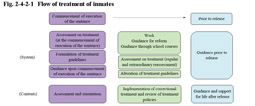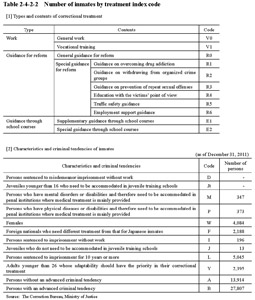Section 2 Treatment of Inmates, etc.
1 Overview of treatment
In accordance with the Penal Detention Facilities Act, the treatment of inmates aims to arouse their motivation to reform and rehabilitate themselves, and to foster their ability to adapt to a social life by making them more self-aware, giving consideration to their individual characteristics and environment, and respecting their human rights. Fig.2-4-2-1 shows the flow of treatment of inmates.
Fig. 2-4-2-1 Flow of treatment of inmates
(1) Treatment index and treatment guidelines
The core part of the correctional treatment consists of work (See the next subsection), guidance for reform, and guidance through school courses (See Subsection 3). The content and manner of the treatment shall depend on the individual characteristics and environment to fit each inmate (principle of individualized treatment).
The personal characteristics and environment of inmates are therefore assessed at each penal institution through utilizing expertise and technology in fields that encompass medicine, psychology, education, and sociology (assessments on treatment). In addition, detailed assessments also take place at special institutions designated as assessment centers of finally sentenced inmates that are considered still young enough to be sufficiently adaptable or those who require more detailed assessments in thereby determining the best way to provide them with special guidance for reform (sexual offenders, etc.).
At penal institutions the inmates are assessed with regard to their treatment (including assessment at assessment centers) upon commencement of their execution of the sentence and an individual treatment index is then specified for each of them according to the results of the assessment. The treatment index consists of both the type and content of the correctional treatment and the characteristics and criminal tendencies of the inmate. Table 2-4-2-2 shows the number of inmates as of the end of 2011 by treatment index code. If deemed appropriate multiple treatment indices can also be specified. For example, inmates sentenced to imprisonment with work for 10 years or more but without any advanced criminal tendencies, and who were deemed appropriate to receive vocational training and general guidance for reform are specified as V0, V1, R0, and LA. The treatment index leads to the assignment of the penal institution where the inmate is to be imprisoned and the priority of his/her treatment. For example, Code LA inmates are placed in penal institutions specialized to hold Code LA inmates while Code R3 inmates are provided with guidance on preventing them from repeating sexual offenses.
Table 2-4-2-2 Number of inmates by treatment index code
Correctional treatment is implemented based on treatment guidelines that specify the goals, basic content, and methods of correctional treatment (for example, specific methods, duration, and frequency of guidance on prevention of repeat sexual offenses, etc.), and the treatment guidelines are specified in accordance with the results of assessments on treatment that take place upon commencement of execution of their sentence.
As described above, the treatment of inmates is implemented as follows: The personal characteristics and environment of the individual inmates are first assessed upon commencement of execution of their sentence and a treatment index and treatment guidelines then get specified using the results of the assessments and their treatment is implemented in accordance with them. Regular and extraordinary reassessments can take place in accordance with the progress of the provided correctional treatment and the results of reassessment can lead to change in the treatment index and treatment guidelines.
(2) Alleviation of restrictions and privilege measures
Inmates face various restrictions in their daily lives and activities in penal institutions. Uniform imposition of severe restrictions on all inmates, however, can dampen their enthusiasm to act in a voluntary/self-motivated manner. The restrictions to maintain discipline and order therefore get gradually alleviated according to the likelihood of their accomplishing the aim of their treatment (thereby raising their motivation to reform and rehabilitate themselves and developing the capability of leading a sound social life), with the restriction classifications ranging from Level 1 through to 4 in the order of being from more alleviated through to stricter, designating each inmate to one of those levels and changing the level regularly or when necessary to help them become self-motivated and independent. The content of restrictions imposed on inmates depends on their restriction level and includes the provision of correctional treatment, etc. inside their cells in general for Level 4 inmates, the provision of correctional treatment, etc. mainly outside their cells (factories, etc.) but within the penal institutions for Level 3 inmates, the possible provision of correctional treatment, etc. outside the penal institutions for Level 2 inmates, and the cells of Level 1 inmates being unlocked, etc. As of April 10, 2012, the result of examining 77 main penal institutions, eight branch prisons, and four large-scale branch detention houses (Sapporo, Yokohama, Saitama, and Kokura) revealed that 428 inmates (0.7%) imprisoned in the institutions were designated as Level 1, 7,513 (12.4%) Level 2, 45,340 (74.8%) Level 3, and 2,221 (3.7%) Level 4, while 5,134 (8.5%) had no specific designation (Source: The Correction Bureau, Ministry of Justice).
In addition, those making the effort to reform/rehabilitate themselves need to be rewarded in thereby raising their individual motivation. Inmates are therefore designated to one of the privilege classifications from Level 1 to 5 in the order of being from good to bad, according to the results of assessments on their attitude which take place every six months. Those with good behavior and therefore designated to high levels have a privilege of having more opportunities to come in contact with people outside and a greater range of self-supplied articles, etc. The result of examining the abovementioned subject penal institutions, as of April 10, 2012, revealed that 452 inmates (0.7%) imprisoned in the institutions were designated to Level 1 privilege classification, 6,897 (11.4%) to Level 2, 25,487 (42.0%) to Level 3, 6,682 (11.0%) to Level 4, and 7,524 (12.4%) to Level 5, while 13,594 (22.4%) had no specific designation (Source: The Correction Bureau, Ministry of Justice).
(3) Day leave and furlough
Inmates that meet certain requirements, such as being likely to accomplish the aim of their treatment, and are therefore receiving treatment in an open facility, are permitted to temporarily leave the penal institution or spend no more than seven days without being accompanied by an institution official when it considered necessary for them to visit someone outside to discuss to secure a residence or an employment after release or to maintain/adjust family relationships, etc., or to visit a volunteer probation officer or anyone else related to their rehabilitation to facilitate their smooth reintegration into society. During the period after the enforcement of the Penal Detention Facilities Act and until the end of May 2012, 31 day leaves and four furloughs were taken.

